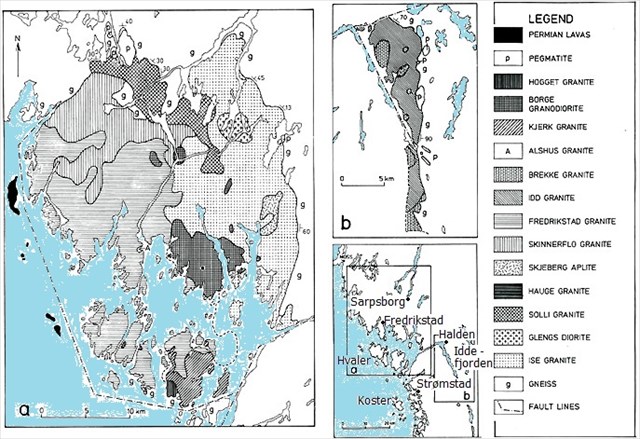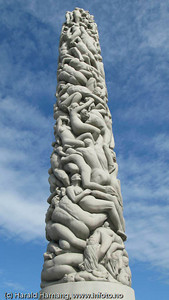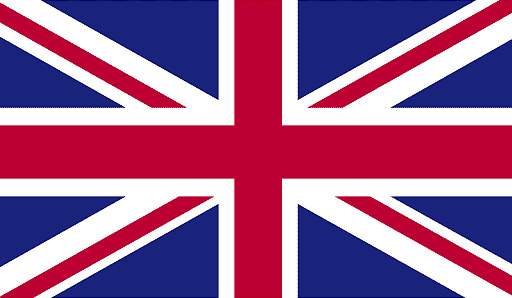
Iddefjordsgranitt
Granitten i Monolitten, og mange andre skulpturer i Vigelandsparken er Iddefjordsgranitt. Iddefjorden er fjorden som deler Norge og Sverige ved Svinesund syd for Halden i Østfold.
Iddefjordsgranitten kalles den del som utgjør den nordlige forlengelsen av den svenske Bohus-granitten som strekker seg fra Lysekil i sør til Råde i nord. Granitten er udeformert og ble dannet i Sveconorwegisk tid for ca. 900 millioner år siden. Granitten intruderte inn i gneiser av forskjellige typer.
 Sammensetningen av Bohus-granitten varierer fra dioritt til granitt og den består av en rekke forskjellige individuelle plutoner. Den svenske og norske del av granitten avviker en del. I Sverige er det vanlig med store områder der gneisbergartene fra "tak" og sidebergarter opptrer internt i granitten, mens dette er sjeldent i norsk sektor.
Sammensetningen av Bohus-granitten varierer fra dioritt til granitt og den består av en rekke forskjellige individuelle plutoner. Den svenske og norske del av granitten avviker en del. I Sverige er det vanlig med store områder der gneisbergartene fra "tak" og sidebergarter opptrer internt i granitten, mens dette er sjeldent i norsk sektor.
Natursteinsproduksjon fra Iddefjordsgranitten startet i 1840-årene men skjøt fart i 1860-årene. Fra starten av var produksjonen i Iddefjorden viktigst. I dette området finnes den største tetthet av brudd og disse var lokalisert slik at det var hensiktsmessig å samordne blokktransport og utskipning.
Spesielt ved Hov og Liholt var produksjonen stor. Ved Liholt var det anlagt en trallebane som transporterte produktene ned til kai. Stein til Vigelandsanleggene ble tatt ut ved Hov. Monolitten ble tatt ut i 1927 og plassert i sin nåværende posisjon i 1943. I dag er all drift på Hov og Liholt nedlagt og de gamle bruddene tildels gjengrodd. (Kilde: ngu.no)
Granitt
Granitt er en størkningsbergart og inneholder per definisjon mer enn 20 prosent kvarts. I tillegg er feltspat og glimmer vanlige mineraler. Fargen varierer fra grå til rødlig, og granittene kan være finkornet eller grovkornet.
Monolitten

Gustav Vigeland er den berømte kunstneren som er opphavet til skulpturene i Vigelandsparken. En av de mest kjente skulpturene i parken er Monolitten. Det er en stor skulptur som er hugget ut i én massiv granitt-blokk, derav navnet (mono: én, litho: sten). Totalhøyen på monolitten er 17.3 m.
Spørsmål/ Questions
- Se nøye på granitten i Monolitten. Hvor stor prosentandelandel sorte partikler anslår du det til å være?
Look closely at the granite in the Monolith. How high do you estimate the content of black particles to be in the granite?
- Kontrollspørsmål: Hvor mange trappetrinn er det opp til platået for Monolitten? (Tips: Mindre enn 50)
Control question: How many steps are there to the plateau of the Monolith? (Hint: Less than 50)
Logging
You may log this cache as normal. But send the answers to Cache-owner (CO), and if there is something obviously wrong, you will be contacted by CO. Adding a picture in the log is optional, but very nice!

Iddefjordsgranite
The granite in the Monolith, and many other sculptures in the Vigeland park is Iddefjordsgranite. The Iddefjord is the fjord separating Norway from Sweden just south of Halden in the county Østfold.
The Iddefjordsgranite is the northern elongation of the Swedish Bohus-granite which exists from Lysekil in South to Råde in North. The granite is undeformed and was formed in Sweconorwegisk time approximately 900 million years ago. Granite intruded into the gneisses of different types.
 The composition of the Bohus granite vary from diorite to granite, it consists of a variety of individual plutons. The Swedish and Norwegian part of the granite differs a lot. In Sweden it is common that large areas where the gneiss rock types from the "roof" and wall rock occur within the granite, but this is rare in the Norwegian sector.
The composition of the Bohus granite vary from diorite to granite, it consists of a variety of individual plutons. The Swedish and Norwegian part of the granite differs a lot. In Sweden it is common that large areas where the gneiss rock types from the "roof" and wall rock occur within the granite, but this is rare in the Norwegian sector.
The production of Iddefjordsgranite in Norway started in the 1840's, and in the 1860's the production was getting quite high. The stone used for the sculptures in the Vigeland park was taken from the quarry at Hov. The Monolith was taken out in 1927, and taken to its current position in 1943. All activity in this quarry is ended a long time ago.
Granite
Granite is a common widely occurring type of intrusive, felsic, igneous rock. Granite usually has a medium- to coarse-grained texture. Occasionally some individual crystals (phenocrysts) are larger than the groundmass, in which case the texture is known as porphyritic. A granitic rock with a porphyritic texture is sometimes known as a porphyry. Granites can be pink to gray in color, depending on their chemistry and mineralogy. By definition, granite is an igneous rock with at least 20% quartz by volume. Granite differs from granodiorite in that at least 35% of the feldspar in granite is alkali feldspar as opposed to plagioclase; it is the alkali feldspar that gives many granites a distinctive pink color.
Granite is an igneous rock and is formed from magma. Granitic magma has many potential origins but it must intrude other rocks. Most granite intrusions are emplaced at depth within the crust, usually greater than 1.5 kilometers and up to 50 km depth within thick continental crust.
The Monolith
Gustav Vigeland is the famous Norwegian artist behind the sculptures in the Vigeland Park, or Frognerparken in Oslo. One of the most famous sculptures in the park is the Monolith. It is a huge sculpture carved in one piece of granite, hence the name (mono: one, litho: stone). The total height is 17.3 m.

